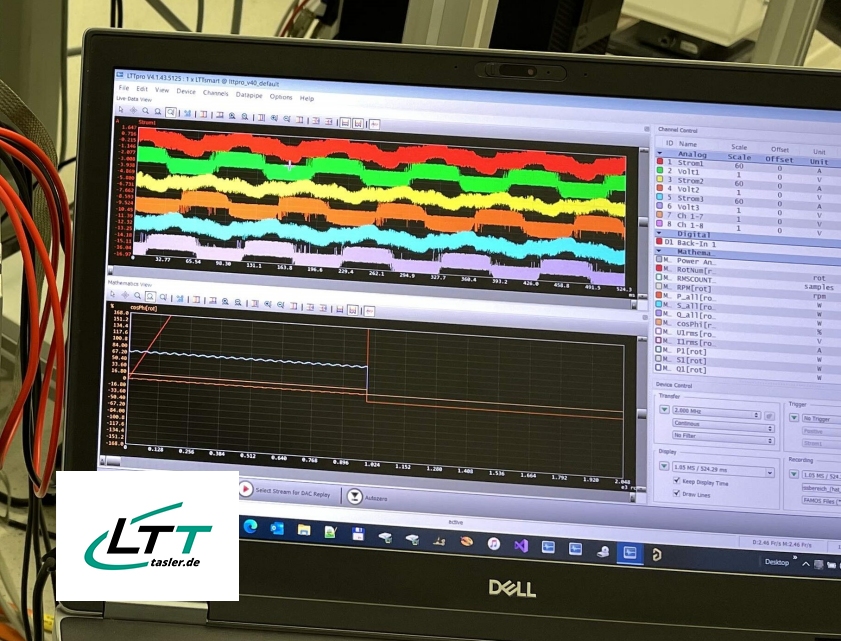

For companies that develop and manufacture integrated systems for the aerospace industry, the use of an accurate power analyzer also has an efficiency-enhancing effect.
Such systems - e.g. landing gear and flight control as well as actuation systems - are used in a wide variety of aircraft and helicopter types. In the development centers, electro-mechanical actuator components of the primary flight controls (these include, for example, elevator, aileron and rudder) with specific signal and power electronics are investigated, among other things. The overall electro-mechanical behavior of these actuators - i.e. dynamic and static performance, frequency response, efficiency, power, etc. - is to be determined within defined environmental conditions.

In addition to speed measurement and current and voltage measurement at converters and motors, a whole range of other parameters must be calculated online for this purpose. These include the active, apparent and reactive power of the overall rotation as well as the power factor cos Phi of the overall setup and also per phase in each case. Considerable demands are placed on the measurement technology used: For example, the required sampling rate is up to 4 MHz. The frequencies of the acquired signals range up to 100 kHz and above. The input voltages are up to 540 VDC (spikes up to 900 V/s) and 115 or 230 VAC up to 800 Hz. The number of channels of the overall system, consisting of measurement data acquisition and control, is more than 120 channels. The time-synchronous, precise acquisition of all relevant electrical, mechanical and hydraulic signals is important.
For fast 3-phase current/voltage measurement, companies in the aviation industry rely on the LTTsmart Power Analyzer from Labortechnik Tasler. The Power Analyzer consists of individual modules, each with two separate and galvanically isolated input channels, and can be flexibly configured in terms of number, sequence and scope of performance. The Power Analyzer - optionally available in a DIN rail or 19" housing or as a portable version - is ideally suited for use on test benches thanks to its measuring accuracy and precision. It offers voltage and current inputs up to ±1000 Vrms, with galvanic isolation up to 2500 VDC, up to 4 MHz sampling rate per channel as well as highly synchronous and extremely low-noise and distortion-free 24-bit A/D converters. The measurement technology from Labortechnik Tasler impresses with the lowest signal distortion on the market, which is an essential basis for precise power analysis, especially with pulsed high-voltage signals.

The specially developed LTTpro Power Analyzer software option, in combination with the LTTsmart, offers a high-performance electrical power measurement perfectly designed for modern electric drives at varying speeds. The LTTsmart uses highly optimized algorithms to determine and display the exact revolution cycles even from highly noisy phase current sinusoidal waveforms. In addition to all the usual performance characteristics, the distortions from all phase currents and voltages are also continuously determined and displayed. The parallel view of raw data and calculated Power Analyzer data immediately reveals the causes behind any anomalies in the performance figures.
On the part of the aviation industry, various systems available on the market for power measurement were evaluated in terms of accuracy and frequency range. One of the main requirements was the possibility of linking the power data with the other test bench data. Another argument in favor of the LTTsmart as a power analyzer was the simple connection to hardware and software from other suppliers, such as Gantner Instruments, Stiegele Datensysteme or DASYLAB from measX. The Power Analyzer guarantees that measurement data, as well as configuration data, can be transmitted constantly and online to the test stand control system. This ensures the traceability of measurements.
The LTTsmart Power Analyzer offers universal application possibilities and the triggering of fast measurement sequences (200ms-300ms) and can also be operated stand-alone with the LTTpro software. The possibility to adapt the calculation algorithms to customer requirements keeps the system flexible.
We will be happy to answer your questions!
Contact us!